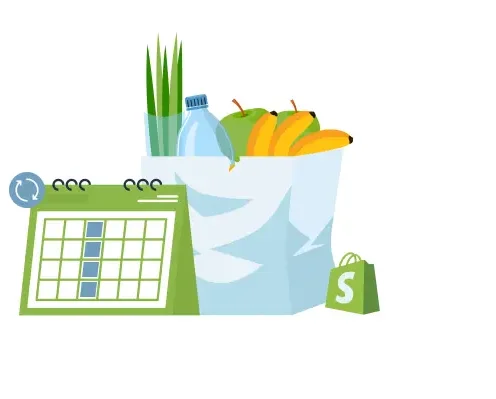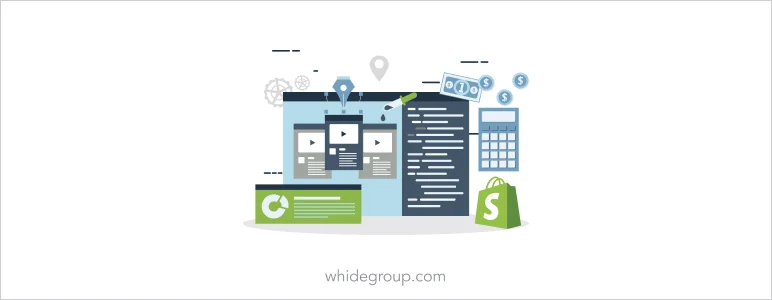How To Sell Subscriptions on Shopify:
a Guide to Selling Products and Services

How To Sell Subscriptions on Shopify:
a Guide to Selling Products and Services
Share post
Nothing speaks to the nature of consumer-culture quite like subscription selling. It’s a perfect recipe, as we can see the ecommerce niche rapidly trying to reach the goal of ultimate convenience. And what is more convenient than signing up for a service once and not worrying about that certain aspect of your life again? Sounds like a great deal.
In fact, it is estimated that 98% of consumers are subscribed to at least one service, while 75% are subscribed to two or more. So, what’s the appeal of selling subscriptions online? And is it possible to sell product subscriptions on Shopify?
Well, today we are going to uncover this topic and explore every possible question related to it.
Table of Contents
ToggleThe very first question that arises is “can you sell subscriptions on Shopify?”. Well, the short answer is “Yes”, but there’s a catch. Shopify doesn’t have a native feature that would enable you to receive recurring billings for a product. So, a better question would be: “can Shopify do recurring payments?”. That is a definite “No”.
However, Shopify recognizes the need and, to ensure recurring revenue, offers merchants the ability to install an app from their Shopify App Store. There are plenty of different subscription apps that will suit any kind of subscription model and business. You also have the option of building a custom subscription app for your store if you find that none of the apps fulfill your needs.
We will return to the ways you can set up recurring payments on Shopify later. For now, let’s unpack what makes the subscription business model so appealing.

Subscription services are truly on the rise with media giants like Netflix and Spotify, which redefined the way we think about ecommerce. Online shoppers also see great value in the ability to just receive items at their doorstep in various frequencies, especially in a post-pandemic world.
Merchants don’t even need to open up another store to introduce a subscription service into their business. With rigorous research and preparation ahead of time, branching into selling product subscriptions could be a pivotal moment for your brand. And for the good.
But can we actually spell out the reasons why your business could benefit from creating such type of business on Shopify? We won’t go on a rant about the miracle promises of this business model. In reality, there are only three reasons why merchants want to sell subscriptions on Shopify:
With that being said, let’s move on and break down four types of ecommerce subscription models.
There are many types of subscription models that exist to cater to different businesses and niches, but we’re going to focus on models that specifically relate to ecommerce. These subscription models are:
Let’s go over each of them in detail.
Curated subscriptions are a kind of service that selects a group of individual products for a customer across their inventory into a curated box. Generally, curated subscription boxes are put together and sent to a customer after they complete a quiz or questionnaire that outlines their preferences.
The success of this subscription model can be attributed to an overly-populated market with lots of stores selling virtually the same products. Curated boxes, on the other hand, provide an added value of a personalized purchase. As well as giving room for a brand to conduct the process of product discovery on the customers’ behalf.
The curated subscription model has a few major advantages that attract merchants. These are:
On the flipside, there are also a few major disadvantages with this model to consider:
So, are there any stores that are successfully selling subscriptions on Shopify? Take a look at WineCollective — a Canadian subscription box that sends professionally curated, hard-to-find wine crates to their subscribers each month. Shoppers can choose one out of three package types to be delivered right to their doorstep. Certainly, a curated service like this found their fair share of loyal customers.

The replenishment subscription business model allows customers to purchase the same items on a recurring basis. Typically, these subscription services involve commodity products, or ones that are used regularly, such as food, bathroom products, and items for pets.
Since most replenishment products are frequently used consumables, a lot of businesses that use this model make eco-friendliness their focal point. After all, if convenience is a selling point of a replenishment model, offering a more consumer-conscious solution makes for a winning strategy.
Some of the advantages of this model include:
Regardless, there are also disadvantages:
To make a replenishment subscription model work, your brand has to either stand out against competition or find a non-competitive niche. Finding a niche that hasn’t been overly saturated can be difficult, but certainly achievable. For example, Fresh Patch is one adorable Shopify store that is selling subscriptions online. Their subscription box sends customers real grass training pads for dogs. They offer various delivery frequencies, from weekly to monthly. Fresh Patch is successful because their product is quite unique and their branding speaks to their audience perfectly.

The “try before you buy” subscription model lets customers try on or test products in the convenience of their home. This kind of subscription model is quite flexible in a way that lets brands tailor terms of use to their business’s needs. Depending on the terms of the “try before you buy” program, customers can subscribe to get miniature versions of the products they like at a small price, order a bunch of products and send back the items they don’t want for free or for a small fee. This model has become popular among cosmetics, clothing, and fashion brands.
The selling point of this subscription option is the possibility to touch, feel, and see what a product looks like in person before making a commitment, which is one of the biggest pain points in ecommerce. However, since customers can send back the items they don’t like, the “try before you buy” model can become a true inventory management nightmare in some cases.
The key advantages of “try before you buy” model include:
The disadvantages are as follows:
Admittedly, this subscription-based model is hard to get right and keep successful long-term. However, learning from the best subscription services, like Birchbox, can steer you in the right direction. This brand offers a $15-per-month subscription box, in which they send beauty and cosmetics product samples based on the customer’s profile and preferences. Birchbox adopted subscription model best practices, which brought them over one million subscribers since their establishment in 2010.

A membership subscription model is a more generalized term for a system where customers pay a monthly subscription fee to gain access to special products, generous discounts, or other members-only deals. While it’s not a standalone subscription business model that would sustain a subscription service, it can be a great addition to any Shopify store, since customers are assured of great deals on products, as well as adding an element of exclusivity.
Introducing a membership subscription is a great way to dip your toes in the water selling subscriptions on Shopify to see whether your customers would be interested. If the launch proves to be successful, you can consider implementing other types of subscription models into your online store.
In a lot of ways, membership subscriptions are a fool-proof way to sell subscriptions on Shopify and have some significant advantages to think about:
And as usual, there are some disadvantages to keep in mind, too:
It won’t be hard to find examples of membership programs, as most ecommerce stores nowadays offer some kind of a membership subscription. The Souled Store, for example, offers a membership subscription that provides shoppers with big discounts, early access, and free shipping on all orders. It’s great value for loyal customers.

Before we can proceed with explaining how to sell subscriptions on Shopify, we want to give you some advice on how to run a profitable subscription sales. There are some subscription model best practices that we want to share with you, so you can make the subscription business model work for your online store.
First and foremost, you’ll need to spend a significant amount of time to choose the right products and test the viability of the subscription model in relation to a particular product or service you want to offer. Many subscription niches are oversaturated, making it considerably more challenging to enter the market. Meaning you have to provide a superior offer and convince consumers to choose your subscription instead of competitors’.
Even if you have a super successful launch, overtime you will notice the unsubscription rate start to rise. So, when a customer cancels their subscription, it gives you a chance to analyze what went wrong. Use surveys and question forms on the subscription cancellation page to understand how to improve your services and keep customers from canceling in the future.
At the beginning, most of your efforts will be centered around customer acquisition. But once you get the ball rolling, you need to start focusing on customer retention. Your current subscribers will be the most important customers, so it’s your duty to keep your services exciting and relevant. Lean into personalizing the overall customer experience by taking suggestions from customers, using questionnaires, and using historical data.

Now that you have the basics of selling subscriptions on Shopify down, it’s time to walk you through the process of setting up a subscription service in your online store!
Setting up a subscription box on Shopify is fairly easy and won’t require any special development knowledge to get up and running. Subscription business models are also quite flexible. They can be a standalone business or an add-on to an existing store. In either case, the process of how to set up subscriptions on Shopify will be mostly the same. Let’s unpack the 6 steps to the full subscription functionality.
It’s pretty obvious, but to start selling subscriptions on Shopify you need to figure out what items you will be selling. If you currently own a business, you can introduce a subscription model into your store to test the waters. You will have plenty of room to try different approaches before you start getting guaranteed revenue each month.
Conversely, you may have an idea to start a separate subscription business entirely. In that case, you must treat this as a new business with all of the predicaments that come with opening up an additional store.
Depending on the products or services you’re going to sell, you will need to choose one subscription model. Of course, your store can offer multiple types of subscription models, but for a brand that is just starting selling subscriptions, it’s best to focus on one model, at least for some time.
Once again, you need to conduct rigorous research to see whether a certain subscription model will be a good fit for the items you will sell. After all, you may have a great start due to an exciting product or other factors. However, if the model is not viable long-term and lacks room for improvement, the subscription service won’t stay afloat.
This step goes without saying, since you will need a store to start selling subscriptions on Shopify. If you haven’t already launched your store, we highly encourage you to read our in-depth Shopify tutorial for beginners to get a headstart. If you are already selling on Shopify, there is nothing else you need to do before continuing with the next step.
One of the biggest pain points of the subscription business model is its operation. Fulfilling subscriptions on time and to a high standard is crucial for retaining subscription customers, especially if customers pay upfront. You will need to establish an inventory and warehouse management system that will work like a clock.
Since you will be selling high volumes of inventory, it might be best to outsource your order fulfillment with fulfillment companies. Such companies will undertake the process of storing, packing, and shipping all of your subscription boxes from the warehouse. This will relieve the burden of carrying out order fulfillment and allow you to focus on other aspects of the business.
As we mentioned before, Shopify lacks the native ability to let you sell subscriptions. Which is why you have to implement Shopify subscription solutions, such as apps, to start your subscription service. The app’s job will be focused around collecting customers’ subscription preferences, capturing payments every cycle, and allowing shoppers to use a dashboard to edit their information.
A little further below, we put together a list of the best Shopify subscription apps that would fit different types of businesses.
Sometimes, merchants find that the available solutions on the App Store just don’t quite fulfill all of the company’s needs. If you find yourself wanting a more tailored approach, building a custom solution can ensure your store works just as you need it to. It is especially valuable, since Shopify introduced a special subscription API that helps developers create a seamless checkout experience by integrating the store’s checkout directly to Shopify.
This means your customers won’t need to go through a separate checkout page to pay for their subscription like they will with a subscription app, which sometimes raises security concerns. The new API also stores payment methods, which allows customers to go through checkout without having to manually enter their card information each time.
We highly recommend you look into reputable development companies that would take on your project with utmost care. It’s best to choose a company that specializes in Shopify development services, as the platform has its own peculiarities and needs to have an educated approach.
Even the most advanced third-party Shopify subscription solutions are not always enough for stores. One of our clients, Postfly, reached out to us to help improve user experience and conversion rate. The subscription app they were using wasn’t efficient enough and required custom changes to streamline the buying process. Our team reworked the subscription page design and customized the default Shopify checkout process to make user experience in the store more enjoyable. You can learn more about Postfly in our dedicated case study.

Like we mentioned before, as the wave of subscription services swept ecommerce, the Shopify App Store began featuring dozens of competitive subscription apps. We brought together a list of the top-rated Shopify subscription solutions and integrations and outlined their most prominent features. Still, you should conduct your own research before committing to any of these apps.
Paywhirl is one of the top-rated subscription apps that fully integrates into Shopify. The app is pretty much a one-stop solution, offering everything you may need in terms of enabling and managing subscription services in your store. Some of the features of PayWhirl include:
PayWhirl would be a great fit for brands that are just starting out in the subscription business and require a basic set of features to run their service. The pricing for the app ranges from completely free to $249 per month.

Bold Subscriptions is a more advanced subscription app for Shopify. It allows you to personalize many aspects of your subscription business, from setting custom delivery intervals to changing how the app looks within a theme. The key features of this app include:
This app would make a good fit for brands that run a medium-size Shopify subscription service and want to have more control over customization of their website. Bold Subscriptions offers one subscription plan for $49,99 per month.

Recharge Subscriptions is the most advanced and complex app for selling subscriptions on Shopify of the three. It allows for the most in-depth customization, both by a merchant in the store and the customer in their dashboard. The selling point of ReCharge Subscriptions is their powerful API that helps to scale any business. As well as other features like:
For brands with a sizable customer base and large variety of subscription boxes, ReCharge Subscriptions would be the best option. Their pricing ranges between $0 to $499 per month.

It is beyond a doubt that subscriptions are here to stay! Online shoppers see great value in being able to receive needed products regularly and in the convenience of their own home. On the other hand, merchants see the appeal of creating a subscription box on Shopify, too. It opens up a completely new way to approach customer loyalty and lifetime value, as well as having a guaranteed steady income each month.
In this article, we went over the different types of subscription models, their challenges and benefits, as well as explored how to sell subscriptions on Shopify so that your business stays profitable for years to come. If you’re interested in starting your own subscription business from the ground up, feel free to get in touch with us for a quote on custom website development. We look forward to working with you!
Share This Article

 Shopify For Photographers: Why and How to Start Selling Photos on Shopify in...
Shopify For Photographers: Why and How to Start Selling Photos on Shopify in...
Consider this: 89% of consumers underestimate how much they spend on subscription services, with the average monthly subscription spend in the US sitting at staggering $273.